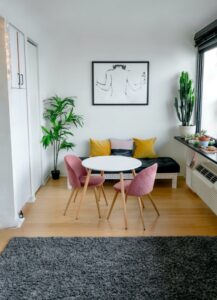A house is often thought of as just a shelter, a place to live. But a home is so much more than that. It’s your sanctuary, a place where you raise your family and find peace and comfort. That’s why it’s important to design your home with your health and wellbeing in mind. From colors and lighting to the overall decor, your home’s design should create a sense of tranquility for your mind, body, and spirit. In this article, we’ll share some home design ideas to help you achieve exactly that.
6 Tips to Design Your Home for Happiness and Mental Wellbeing
1. Opt for good interior design
When you’re planning your interior decor, never compromise on your wellbeing and health. Take the layout of the space into account and aim to create a place that’s both convenient and practical. Choose top-notch materials, like investing in high-quality insulation products insulation products for your walls, floor, and roof from a reputable supplier, or selecting the best hardwood flooring available. Making your space comfortable and stylish means using the best materials that your budget allows.
2. Go big
Instead of a plethora of small artifacts placed around your living room (or any other space for that matter), focus on having one large decorative item instead. Too many small items around evoke nervousness and can make you feel more disoriented. Try this instead: a large sofa or a dazzling Ottoman; a vintage mirror across one wall; one or two paintings rather than saturating the wall with numerous shelves. The key to creating a home that promotes wellbeing is to go minimalist with a “wow” effect.
3. Design for natural light
Natural lighting in homes have a profound positive impact on both mental and physical health. A well-lit environment also boosts productivity, concentration, and creativity. There is research to indicate that exposure to daylight regulates your circadian rhythms — that means it helps maintain a healthy sleep-wake cycle and improves the quality of your sleep. When you are in the presence of bright daylight, your mood improves because it increases the production of serotonin, a neurotransmitter associated with wellbeing. With so much evidence supporting the goodness of daylight, it only makes sense that you design your walls to include at least one large, possibly top-to-bottom, window to bring in as much natural light as possible.
4. Choose soft wall hues
To maximize your wellbeing, paint your walls with natural tones like soft greens and earthy browns for a calming atmosphere, complemented by neutrals for versatility and light colors to create brightness. Warm colors can be used as accents for energy and warmth, aligning your choices with the room’s purpose and size. Test colors in different lighting. It would be wise to learn about the psychological effects of colors and choose colors that make you personally feel comfortable and happy, as your own emotional connection to them is vital for your wellbeing.
Related » How the Colours in Your Home Affect Your Moods

5. Bring nature in
To enhance your health and wellness through indoor plants, try positioning them strategically throughout your home. Place larger, leafy ones like snake plants or peace lilies in living areas and bedrooms to purify the air and provide a calming presence. Add smaller succulents or herb plants to kitchen windowsills or bathrooms for a touch of nature and aromatherapy. And yes, don’t forget to consider the lighting requirements of each plant species and ensure proper care to maintain their health. Grouping plants together in clusters can create a more visually appealing and inviting atmosphere, fostering a sense of tranquility and connection with nature indoors.
Related » No Space for Plants at Home? Try Inverted Gardening
6. Go for sleek organic furnishings
Did you know, that using organic materials for furnishings and upholstery at home offers a range of benefits? Organic materials that are derived from natural sources are free from harmful chemicals and synthetic additives. Plus, they are biodegradable, having a far less environmental impact than their synthetic counterparts. Organic furnishings can also be more durable and age gracefully, offering long-term value. Their natural textures and aesthetics bring a sense of warmth into your living space. Ultimately, choosing organic materials for furnishings contributes to a healthier, eco-friendly, and aesthetically pleasing home environment.
Conclusion
In the quest to turn a house into a home, one thing becomes clear: it’s not just about shelter; it’s about creating a sanctuary for your family, a place where comfort and serenity reign. This calls for mindful design, one that prioritizes wellbeing. From selecting quality materials to embracing natural light and harmonious color schemes, every aspect of your home contributes to your mental and physical health. The tips shared in this article are meant to serve as a guide, helping you to see how your home is more than just a structure — it can be a haven for happiness and wellness. By integrating these principles and connecting with nature through indoor plants and organic furnishings, you will not only make your spaces more beautiful but also contribute to a healthier, eco-friendly, and aesthetically pleasing environment.
 Spot an error in this article? A typo maybe? Or an incorrect source? Let us know!
Spot an error in this article? A typo maybe? Or an incorrect source? Let us know!
